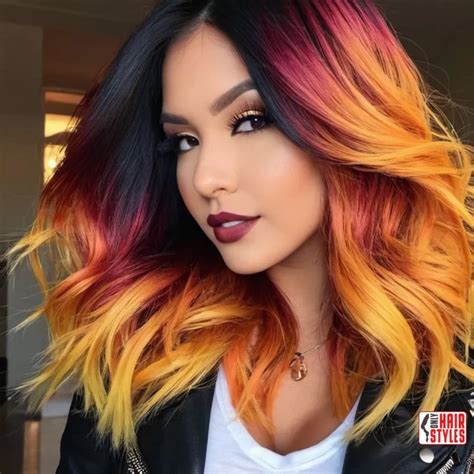Introduction: The Rise and Relevance of Ombre Hair
Since its inception in the early 2010s, ombre hair has gained immense popularity, becoming a staple in the hair coloring industry. The term “ombre,” derived from the French word for “shadow,” aptly describes this technique that involves a gradual transition from one hair color to another, typically from darker roots to lighter ends. As per industry reports, the demand for ombre hair services has surged by 43% in the past five years.

Types of Ombre Hair Color
The versatility of ombre hair allows for a wide range of styles to suit individual preferences. Here are some popular types:
- Root Smudge Ombre: This technique involves blending the roots with a darker shade, creating a subtle and natural transition.
- Classic Ombre: The traditional ombre style features a sharp transition from dark roots to light ends, with a visible line of demarcation.
- Reverse Ombre: Also known as “sombre,” this technique reverses the traditional ombre pattern, starting with light roots that gradually blend into darker ends.
- Multidimensional Ombre: This style incorporates multiple shades of color, creating a complex and dynamic look.
- Balayage Ombre: Balayage, a French technique that involves hand-painting color onto the hair, can be used to create a soft and blended ombre effect.
Benefits of Ombre Hair
- Low Maintenance: Unlike traditional hair coloring, ombre hair does not require frequent touch-ups, making it an ideal choice for those who value convenience and time-saving.
- Versatility: Ombre hair can be tailored to any hair length or texture, providing a flattering look for all hair types and face shapes.
- Trendy and Timeless: Ombre hair has consistently remained popular, offering a stylish and modern touch to any hairstyle.
How to Choose the Right Ombre Hair Color
Selecting the perfect ombre hair color depends on several factors:
- Skin Tone: Warm skin tones complement warmer shades like honey blonde or caramel brown, while cool skin tones suit cooler shades like ash blonde or icy platinum.
- Natural Hair Color: The natural hair color provides a base for the ombre effect. Darker hair typically requires more bleaching to achieve lighter ends.
- Personal Style: The ombre hair color should align with one’s overall style and desired look.
Steps for Achieving Ombre Hair Color
The ombre hair coloring process typically involves the following steps:
- Pre-Lightening: Selected areas of the hair are bleached to prepare them for the darker.
- Toning: The pre-lightened hair is treated with a toner to achieve the desired blonde shade.
- Coloring: The roots are colored to create the dark base for the ombre effect.
- Blending: The transition area between the dark roots and light ends is carefully blended using a comb or brush.
Tips and Tricks for Ombre Hair
- Use a Professional: Ombre hair requires technical skill and expertise. It is recommended to seek the services of a professional hairstylist to ensure a flawless result.
- Protect Your Hair: Bleaching and coloring can damage hair, so regular deep conditioning treatments are essential to maintain hair health.
- Consider Your Lifestyle: Ombre hair may require additional styling time and effort compared to traditional hair coloring methods.
- Experiment with Different Shades: Ombre hair offers endless possibilities for color combinations. Experiment with different shades to find the perfect match for your style and personality.
FAQs About Ombre Hair
1. What is the difference between ombre and balayage?
Ombre involves a more distinct and gradual transition from dark roots to light ends, while balayage creates a softer, more natural-looking blend of colors.
2. How long does it take to get ombre hair?
The time required for ombre hair coloring can vary depending on the length, thickness, and desired effect, but typically ranges from 3 to 6 hours.
3. How often do I need to touch up my ombre hair?
Ombre hair requires less frequent touch-ups compared to traditional hair coloring. On average, a touch-up every 3-6 months is sufficient to maintain the look.
4. Can I do ombre hair at home?
Attempting ombre hair at home is not recommended unless you have prior hair coloring experience and the necessary tools. Professional hairstylists have the knowledge and expertise to ensure a successful outcome.
5. How do I care for ombre hair?
Regular hair care is essential for maintaining the health of ombre hair. Use sulfate-free shampoos and conditioners, avoid over-styling, and protect the hair from sun exposure with UV-protective products.
6. Is ombre hair suitable for all hair types?
Ombre hair can be tailored to suit all hair types, including curly, straight, fine, and thick hair. However, it may require specialized techniques for different hair textures.
Conclusion: The Enduring Appeal of Ombre Hair
Ombre hair has become a staple in the hair coloring industry, captivating countless individuals with its versatility, low maintenance, and timeless appeal. With meticulous attention to the client’s skin tone, natural hair color, and personal style, skilled hairstylists can create stunning ombre hair color looks that enhance individual beauty and express unique personalities. As the trend continues to evolve, ombre hair will undoubtedly remain a popular choice for years to come.
